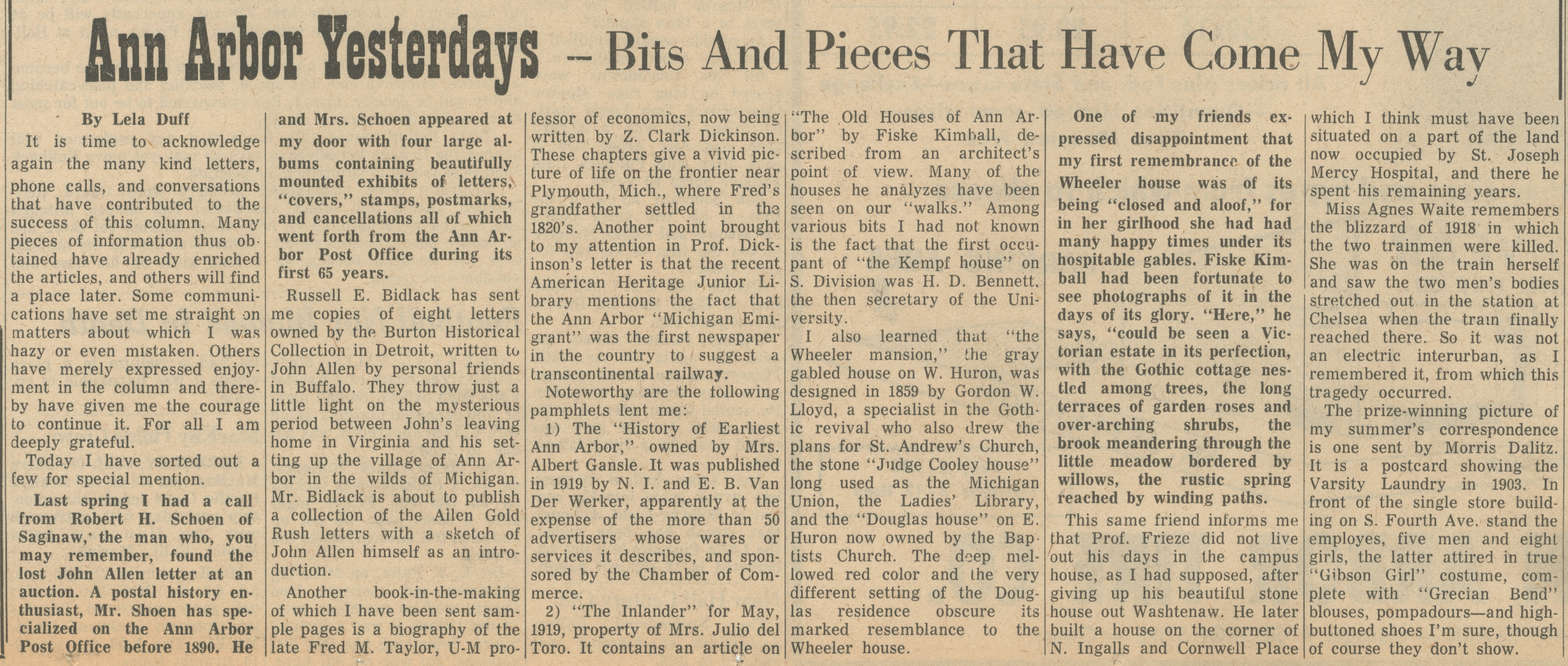Ann Arbor Yesterdays ~ Bits And Pieces That Have Come My Way

Ann Arbor Yesterdays - Bits And Pieces That Have Come My Way
By Lela Duff
It is time to acknowledge again the many kind letters, phone calls, and conversations that have contributed to the success of this column. Many pieces of information thus obtained have already enriched the articles, and others will find a place later. Some communications have set me straight on matters about which I was hazy or even mistaken. Others have merely expressed enjoyment in the column and thereby have given me the courage to continue it. For all I am deeply grateful.
Today I have sorted out a few for special mention.
Last spring I had a call from Robert H. Schoen of Saginaw, the man who, you may remember, found the lost John Allen letter at an auction. A postal history enthusiast, Mr. Shoen has specialized on the Ann Arbor Post Office before 1890. He and Mrs. Schoen appeared at my door with four large albums containing beautifully mounted exhibits of letters, “covers,” stamps, postmarks, and cancellations all of which went forth from the Ann Arbor Post Office during its first 65 years.
Russell E. Bidlack has sent me copies of eight letters owned by the Burton Historical Collection in Detroit, written to John Allen by personal friends in Buffalo. They throw just a little light on the mysterious period between John’s leaving home in Virginia and his setting up the village of Ann Arbor in the wilds of Michigan. Mr. Bidlack is about to publish a collection of the Allen Gold Rush letters with a sketch of John Allen himself as an introduction.
Another book-in-the-making of which I have been sent sample pages is a biography of the late Fred M. Taylor, U-M professor of economics, now being written by Z. Clark Dickinson. These chapters give a vivid picture of life on the frontier near Plymouth, Mich., where Fred’s grandfather settled in the 1820’s. Another point brought to my attention in Prof. Dickinson’s letter is that the recent American Heritage Junior Library mentions the fact that the Ann Arbor “Michigan Emigrant” was the first newspaper in the country to suggest a transcontinental railway.
Noteworthy are the following pamphlets lent me:
1) The “History of Earliest Ann Arbor,” owned by Mrs. Albert Gansle. It was published in 1919 by N. I. and E. B. Van Der Werker, apparently at the expense of the more than 50 advertisers whose wares or services it describes, and sponsored by the Chamber of Commerce.
2) “The Inlander” for May, 1919, property of Mrs. Julio del Toro. It contains an article on "The Old Houses of Ann Arbor” by Fiske Kimball, described from an architect’s point of view. Many of the houses he analyzes have been seen on our "walks.” Among various bits I had not known is the fact that the first occupant of “the Kempf house” on S. Division was H. D. Bennett, the then secretary of the University.
I also learned that “the Wheeler mansion,” the gray gabled house on W. Huron, was designed in 1859 by Gordon W. Lloyd, a specialist in the Gothic revival who also drew the plans for St. Andrew’s Church, the stone “Judge Cooley house” long used as the Michigan Union, the Ladies’ Library, and the “Douglas house" on E. Huron now owned by the Baptists Church. The deep mellowed red color and the very different setting of the Douglas residence obscure its marked resemblance to the Wheeler house.
One of my friends expressed disappointment that my first remembrance of the Wheeler house was of its being “closed and aloof,” for in her girlhood she had had many happy times under its hospitable gables. Fiske Kimball had been fortunate to see photographs of it in the days of its glory. “Here,” he says, “could be seen a Victorian estate in its perfection, with the Gothic cottage nestled among trees, the long terraces of garden roses and over-arching shrubs, the brook meandering through the little meadow bordered by willows, the rustic spring reached by winding paths.
This same friend informs me that Prof. Frieze did not live out his days in the campus house, as I had supposed, after giving up his beautiful stone house out Washtenaw. He later built a house on the corner of N. Ingalls and Cornwell Place which I think must have been situated on a part of the land now occupied by St. Joseph Mercy Hospital, and there he spent his remaining years.
Miss Agnes Waite remembers the blizzard of 1918 in which the two trainmen were killed. She was on the train herself and saw the two men’s bodies stretched out in the station at Chelsea when the tram finally reached there. So it was not an electric interurban, as I remembered it, from which this tragedy occurred.
The prize-winning picture of my summer’s correspondence is one sent by Morris Dalitz. It is a postcard showing the Varsity Laundry in 1903. In front of the single store building on S. Fourth Ave. stand the employes, five men and eight girls, the latter attired in true "Gibson Girl” costume, complete with “Grecian Bend” blouses, pompadours—and high-buttoned shoes I’m sure, though of course they don’t show.
Article
Subjects
Lela Duff
Varsity Laundry
University of Michigan - Faculty & Staff
St. Joseph Mercy Hospital
Local History
Kempf House
Historic Buildings
Burton Historical Collection
Books & Authors
Architects
Ann Arbor Yesterdays
Old News
Ann Arbor News
Z. Clark Dickinson
Russell E. Bidlack
Robert H. Schoen
N. I. Van Der Werker
Mrs. Julio del Toro
Mrs. Albert Gansle
Morris Dalitz
John Allen
H. D. Bennett
Gordon W. Lloyd
Fred M. Taylor
Fiske Kimball
E. B. Van Der Weker
Ailen Gold Rush
Agnes Waite